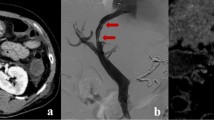Abstract
Purpose
To evaluate the safety and efficacy of transjugular intrahepatic portosystemic shunt (TIPS) in the control of bleeding from ectopic varices.
Methods
From 1995 to 2004, 24 cirrhotic patients, bleeding from ectopic varices, mean age 54.5 years (range 15–76 years), were treated by TIPS. The etiology of cirrhosis was alcoholic in 13 patients and nonalcoholic in 11 patients. The location of the varices was duodenal (n = 5), stomal (n = 8), ileocolic (n = 6), anorectal (n = 3), umbilical (n = 1), and peritoneal (n = 1).
Results
TIPS controlled the bleeding in all patients and induced a decrease in the portacaval gradient from 19.7 ± 5.4 to 6.4 ± 3.1 mmHg. Postoperative complications included self-limited intra-abdominal bleeding (n = 2), self-limited hemobilia (n = 1), acute thrombosis of the shunt (n = 1), and bile leak treated by a covered stent (n = 1). Median follow-up was 592 days (range 28–2482 days). Rebleeding occurred in 6 patients. In 2 cases rebleeding was observed despite a post-TIPS portacaval gradient lower than 12 mmHg and was controlled by variceal embolization; 1 patient underwent surgical portacaval shunt and never rebled; in 3 patients rebleeding was related to TIPS stenosis and treated with shunt dilatation with addition of a new stent. The cumulative rate of rebleeding was 23% and 31% at 1 and 2 years, respectively. One- and 2-year survival rates were 80% and 76%, respectively.
Conclusion
The present series demonstrates that bleeding from ectopic varices, a challenging clinical problem, can be managed safely by TIPS placement with low rebleeding and good survival rates.



Similar content being viewed by others
References
Norton ID, Andrews JC, Kamath PS (1998) Management of ectopic varices. Hepatology 28:1154–1158
Boyer TD (2003) Transjugular intrahepatic portosystemic shunt: Current status. Gastroenterology 124:1700–1710
Pomier-Layrargues G, Villeneuve JP, Deschenes M, et al. (2001) Transjugular intrahepatic portosystemic shunt (TIPS) versus endoscopic variceal ligation in the prevention of variceal rebleeding in patients with cirrhosis: A randomised trial. Gut 48:390–396
Casado M, Bosch J, Garcia-Pagan J, et al. (1998) Clinical events after transjugular intrahepatic portosystemic shunt: Correlation with hemodynamic findings. Gastroenterology 114:1296–1303
Lafortune M, Martinet JP, Denys A, et al. (1995) Short- and long-term hemodynamic effects of transjugular intrahepatic portosystemic susnts: A Doppler/manometric correlative study. AJR Am J Roentgenol 164:997–1002
Hosking SW, Smart HL, Johnson AG, et al. (1989) Anorectal varices, hemorrhoids and portal hypertension. Lancet I:349–352
Kinkhabwala M, Mousavi A, Iyer S, et al. (1977) Bleeding ileal varicosity demonstrated by transhepatic portography. AJR Am J Roentgenol 129:514–516
Khouqeer F, Morrow C, Jordan P (1987) Duodenal varices as a cause of massive upper gastrointestinal bleeding. Surgery 102:548–552
Kakizaki S, Ishikawa T, Koyama Y, et al. (2003) Primary biliary cirrhosis complicated with sigmoid colonic varices: The usefulness of computed tomographic angiography. Abdom Imaging 28:831–834
Handschin AE, Weber M, Weishaupt D, et al. (2002) Contrast-enhanced three-dimensional magnetic resonance angiography for visualization of ectopic varices. Dis Col Rectum 45:1541–1544
Kishimoto K, Hara A, Arita T, et al. (1999) Stomal varices: Treatment by percutaneous transhepatic coil embolization. Cardiovasc Intervent Radiol 22:523–525
Jonnalagadda SS, Quiason S, Smith OJ (1998) Successful therapy of bleeding duodenal varices by TIPS after failure of sclerotherapy. Am J Gastroenterol 93:272–274
Sarfeh IJ, Rypins EB (1986) The emergency portacaval H graft in alcoholic cirrhotic patients: Influence of shunt diameter on clinical outcome. Am J Surg 152:290–293
Bureau C, Garcia-Pagan JC, Otal P, et al. (2004) Improved clinical outcome using polytetrafluoroethylene coated stents for TIPS: Results of a randomized study. Gastroenterology 126:469–475
Hidajat N, Stobb H, Hosten N, et al. (2002) Transjugular intrahepatic shunt and transjugular embolization of bleeding rectal varices in portal hypertension. AJR Am J Roentgenol 178:362–363
Fantin AC, Zala G, Risti B, et al. (1996) Bleeding anorectal varices : Successful treatment with transjugular intrahepatic portosystemic shunting (TIPS). Gut 38:932–935
Morris CS, Najarian KE (2000) Transjugular intrahepatic portosystemic shunt for bleeding stomal varices associated with chronic portal vein occlusion: Long-term angiographic, hemodynamic, and clinical follow-up. Am J Gastroenterol 95:2966–2968
Bernstein D, Yrizarry J, Reddy KR, et al. (1996) Transjugular intrahepatic portosystemic shunt in the treatment of intermittently bleeding stomal varices. Am J Gastroenterol 91:2237–2238
Katz JA, Rubin RA, Cope C, et al. (1993) Recurrent bleeding from anorectal varices: Successful treatment with a transjugular intrahepatic portosystemic shunt. Am J Gastroenterol 88:1104–1107
Johnson PA, Laurin J (1997) Transjugular portosytemic shunt for treatment of bleeding stomal varices. Dig Dis Sci 42:440–442
Ory G, Spahr L, Megevand JM, et al. (2001) The long-term efficacy of the intrahepatic portosystemic shunt (for the treatment of bleeding anorectal varices in cirrhosis. A case report and review of the literature. Digestion 64:261–264
Haskal ZJ, Scott M, Rubin RA, et al. (1994) Intestinal varices: Treatment with the transjugular intrahepatic portosystemic shunt. Radiology 191:183–187
Shibata D, Brophy DP, Gordon FD, et al. (1999) Transjugular intrahepatic portosystemic shunt for treatment of bleeding ectopic varices with portal hypertension. Dis Col Rectum 42:1581–1585
Vangeli M, Patch D, Terreni N, et al. (2004) Bleeding ectopic varices treatment with transjugular intrahepatic portosystemic shunt (TIPS) and embolisation. J Hepatol 41:560–566
Acknowledgments
The authors thank Mrs. Manon Bourcier for editing the manuscript and Dr. Daphna Fenyves for reviewing the paper.
Author information
Authors and Affiliations
Corresponding author
Rights and permissions
About this article
Cite this article
Vidal, V., Joly, L., Perreault, P. et al. Usefulness of Transjugular Intrahepatic Portosystemic Shunt in the Management of Bleeding Ectopic Varices in Cirrhotic Patients. Cardiovasc Intervent Radiol 29, 216–219 (2006). https://doi.org/10.1007/s00270-004-0346-4
Published:
Issue Date:
DOI: https://doi.org/10.1007/s00270-004-0346-4




